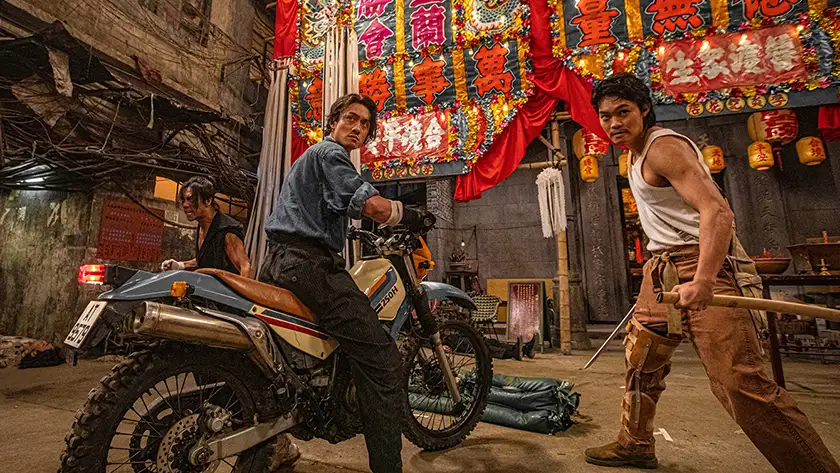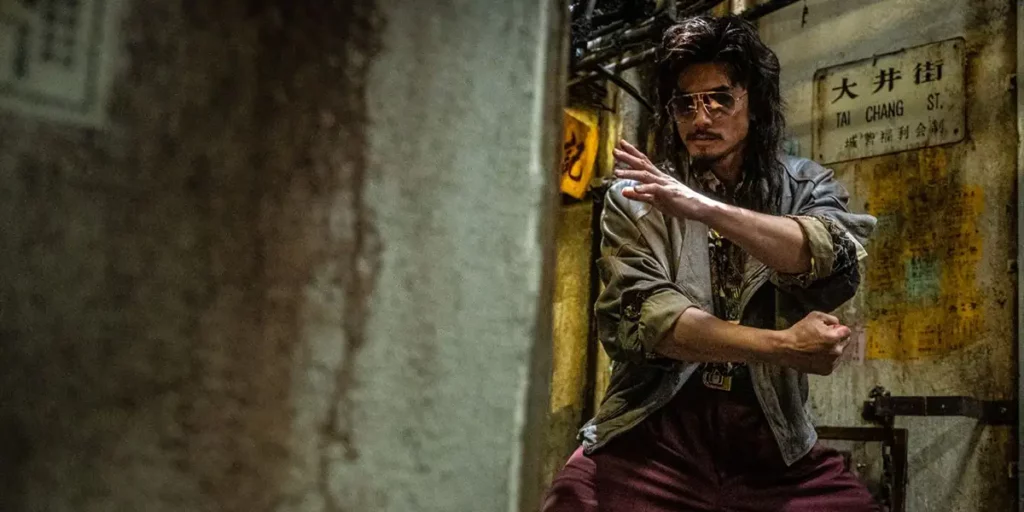Soi Cheang creates a new style of gravity-defying action in his latest movie, Twilight of the Warriors: Walled In, the first part in a planned trilogy.
Director: Soi Cheang
Genre: Action, Crime, Thriller
Run Time: 126′
US Release: May 23, 2024 in select US theaters
UK Release: August 9, 2024 in UK & Irish cinemas
Streaming Release: TBA
The first in a three-part trilogy, Twilight of the Warriors: Walled In sees Chan Lok-kwun (Raymond Lam) enter the Kowloon Walled City after he steals a bag filled with drugs supplied by Mr. Big (Sammo Hung). We learn that the Walled City is under the rule of Cyclone (Louis Koo), who has been fighting with other factions on the rule of the city (which will likely be explored in the franchise’s second part, Dragon Throne, but is only briefly alluded to in an opening flashback).
More details then come into play, and a plot is made to take down Lok, who has stolen far more drugs than he thinks. Cyclone, who was initially not on his side, joins him to defeat Mr. Big’s criminal empire. There, we learn that the drug lord has made a backhand deal with Cyclone’s boss, Chau (Richie Chen), for total control of the city’s operations, should they successfully eliminate Lok and Cyclone from the Walled City.
There’s arguably lots of exposition at the beginning of the film, particularly in how director Soi Cheang introduces the characters and dense world that will populate Twilight of the Warriors. Most of it is gripping and works in the film’s favor, while other sections feel incomplete and tease the promise of something bigger. Of course, knowing that it is the first part of a planned trilogy, and an adaptation of Yuyi’s City of Darkness, not everything will be completely resolved, nor will the film’s overarching narrative feel whole.
But Cheang does not end his movie with a cliffhanger and satisfyingly concludes the first part of his trilogy as a bookend to the era he depicted in Walled In (the second part will be a prequel set in the 1950s and 1960s). He respects the audience on the level of promising them a more complete story with the second chapter, which will fill in the missing narrative gaps in Walled In, while also ensuring that the story he is currently telling has an ending and doesn’t simply tease part two without a care in the world. Most ‘Part Ones’ lack the sense of closure, but Cheang is a smart enough filmmaker (who has previously made a trilogy out of The Monkey King) to know this is not the way to end any movie.
That’s why there’s a sense of closure in his story, and if anyone isn’t willing to continue on the journey, they won’t feel cheated for having sat through two hours of exposition with little to no emotional payoff. And while the exposition may feel dense at first, the payoff Cheang ultimately gives to Lok-kwun is immense. Some character decisions may not make sense at first, but once you think about how Cheang and writers Au Kin-yee, Shum Kwan-sin, Chan Taili, and Lai Chung shape Lok-kwun’s arc within the confines of the Walled City, it begins to unravel in the most satisfying way possible, even with splashes of magic transforming what could be gritty crime thriller into an almost fantastical, otherworldly actioner.

Cheang’s style of action can’t be labeled as following in the footsteps of one specific filmmaker. He’s teetering on the edge of Johnnie To and Tsui Hark before incorporating Wuxia or even Kollywood surrealism into the mix (S. Shankar? Anyone?). It makes zero sense to have a character with magical powers that block any attack (unless they get a razor blade down their throat in the film’s most gruesome scene), or characters that get thrown to a wall as if they’re a paperweight. The way they jump into the air almost feels as if the boxed-in skies of the Walled City have zero gravity, which allows Cheang and cinematographer Cheng Siu-keung to craft fight scenes that are always built within the lines of realistic and fantastical.
Yet, when King (Philip Ng) shows up and utilizes his powers to block the attacks from the protagonists, you don’t question it. It makes perfect sense that Cheang would incorporate magical elements like these in his film, which, in turn, gives the action more emotional weight and intensity. Had it been standard martial arts fare, it would be competent and effective, but not as unique as the stamp Cheang gives to the material. Each sparse splash of a magical martial arts move makes the action feel alive and stimulating. This is more than ‘just a martial arts film;’ it’s a completely unique style that has never been treated this way on screen before, even through the Shaw Brothers.
By doing so, Cheang brilliantly celebrates the legacy of Hong Kong cinema, without it ever feeling like a pastiche. He’s a fan of Johnnie To, Tsui Hark, Lau Kar-leung, King Hu, and Sammo Hung (the latter appears in his film), and wants each possible actor to showcase their dexterity as martial artists first and foremost before actors. All the stars are great in their roles, but they’re even better martial artists fighting in what looks impossible-to-choreograph and execute brawls. Koo, in particular, has to make it believable that a chainsmoking terminal lung cancer patient who constantly coughs up blood can hold his own against Mr. Big’s army of goons.
Cyclone even gracefully uses his cigarettes as a fight prop – it’s not only a habit (or, in this case, an addiction completely killing him), but a lifestyle he’s now fully ingrained as part of his being and martial arts. In the film’s most badass moment, the cigarette becomes the most essential weapon for Cyclone’s survival, even if he’s dying from it. Weird, I know, and you’re either suspending your disbelief and fully buying into Cheang’s magical world, or nitpicking at how ‘unrealistic’ everything is.
But it makes even more sense when you realize that Cheang isn’t simply drawing from Yuyi’s book, but also the manhua that takes a grounded story into more outlandish heights. After that, you completely understand why Cheang told his story the way he did, and why subsequent installments won’t dial down on the otherworldly, but exacerbate it to create even more mind-blowing feats of action and derring-do. In the hands of a lesser-than capable director, Twilight of the Warriors: Walled In could’ve failed with the same approach.
Not only does Soi Cheang know how to frame and shoot action in an effective, almost cathartic way; he knows how to develop a style that will never be replicated or imitated. He fully knows he can’t do what Lau Kar-leung did, or Johnnie To. That’s why he combines the two and creates his own brand of action that’s never a blatant reference to a filmmaker, but is decidedly Soi Cheang. With Twilight of the Warriors: Walled In, he creates a rich world rife with an incredible potential for development and action that will only grow more insane as the films continue.
Perhaps he’s cheating for making several plot threads and character arcs feel incomplete. But I’ve also not been more excited about a potential franchise in a very long time, and to see it realized the way Cheang is doing it could very well mean that he’s on his way to making his masterpiece after a prolific career of revolutionizing the landscape of Hong Kong cinema for the better. Here’s hoping his fully-realized vision will be just as incredible as this installment.
Twilight of the Warriors: Walled In will be released in select US theaters on August 9, 2024.

